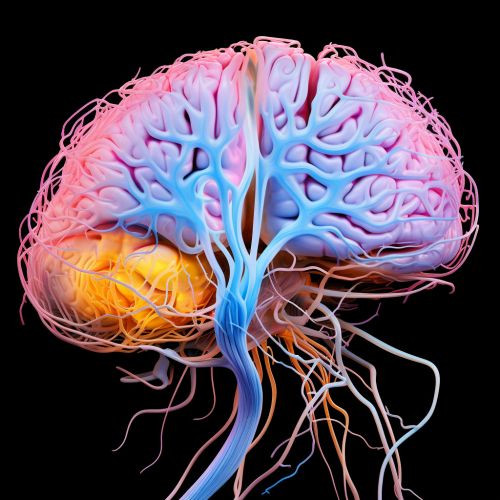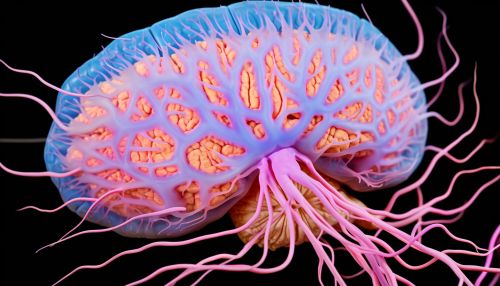Basal Ganglia
Overview
The basal ganglia are a group of subcortical nuclei, located deep within the cerebral hemispheres, that play a central role in a variety of motor and cognitive functions. These nuclei include the striatum, globus pallidus, subthalamic nucleus, and substantia nigra. The basal ganglia are interconnected with the cerebral cortex, thalamus, and brainstem, as well as several other brain areas. The basal ganglia are associated with a variety of functions, including control of voluntary motor movements, procedural learning, habit learning, eye movements, cognition, and emotion.


Anatomy
The basal ganglia consist of a group of nuclei that are interconnected with the cerebral cortex, thalamus, and brainstem. The main components of the basal ganglia are the striatum, globus pallidus, subthalamic nucleus, and substantia nigra.
Striatum
The striatum, the largest nucleus within the basal ganglia, is divided into the dorsal striatum (caudate nucleus and putamen) and the ventral striatum (nucleus accumbens and olfactory tubercle). The striatum receives input from many areas of the cerebral cortex and is the primary input to the rest of the basal ganglia.
Globus Pallidus
The globus pallidus is divided into two parts: the globus pallidus externus (GPe) and the globus pallidus internus (GPi). The GPe and GPi are the primary output structures of the basal ganglia, sending inhibitory projections to the thalamus and brainstem.
Subthalamic Nucleus
The subthalamic nucleus (STN) is a small, lens-shaped nucleus that is part of the diencephalon. It receives excitatory input from the cortex and sends excitatory output to the globus pallidus and substantia nigra.
Substantia Nigra
The substantia nigra is divided into two parts: the substantia nigra pars compacta (SNc) and the substantia nigra pars reticulata (SNr). The SNc contains dopaminergic neurons that project to the striatum, while the SNr is a major output nucleus of the basal ganglia.
Function
The basal ganglia play a crucial role in a variety of functions. These include motor control, learning, and emotion.
Motor Control
The basal ganglia are involved in the control of voluntary motor movements. They do not initiate movement, but they contribute to the planning and execution of complex motor responses, and they help to regulate movements initiated by the cortex.
Learning
The basal ganglia are also involved in procedural learning, which is the learning of new skills and habits. This type of learning is often unconscious and is demonstrated by improved performance with practice.
Emotion
The basal ganglia, particularly the ventral striatum, are involved in the processing of reward and the regulation of mood. Dysfunction in these areas has been linked to mood disorders such as depression and anxiety.
Pathology
Dysfunction of the basal ganglia can lead to a variety of neurological and psychiatric disorders. These include Parkinson's disease, Huntington's disease, Tourette syndrome, obsessive-compulsive disorder, and addiction.
Parkinson's Disease
Parkinson's disease is a neurodegenerative disorder characterized by the loss of dopaminergic neurons in the substantia nigra. This leads to a reduction in the inhibitory output of the basal ganglia, resulting in motor symptoms such as tremor, rigidity, and bradykinesia.
Huntington's Disease
Huntington's disease is a genetic disorder characterized by the degeneration of neurons in the striatum. This leads to a variety of symptoms, including chorea, cognitive decline, and psychiatric symptoms.
Tourette Syndrome
Tourette syndrome is a neurodevelopmental disorder characterized by motor and vocal tics. It is thought to be related to dysfunction in the basal ganglia and their connections with the cortex.
Obsessive-Compulsive Disorder
Obsessive-compulsive disorder (OCD) is a psychiatric disorder characterized by obsessions and compulsions. It is thought to be related to dysfunction in the basal ganglia and their connections with the frontal cortex.
Addiction
Addiction is a chronic disorder characterized by compulsive drug seeking and use, despite harmful consequences. It is thought to be related to dysfunction in the basal ganglia, particularly the ventral striatum, which is involved in reward processing.
